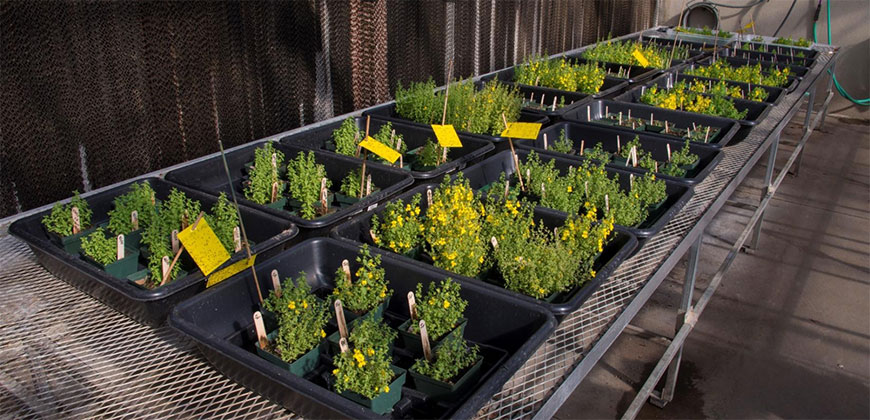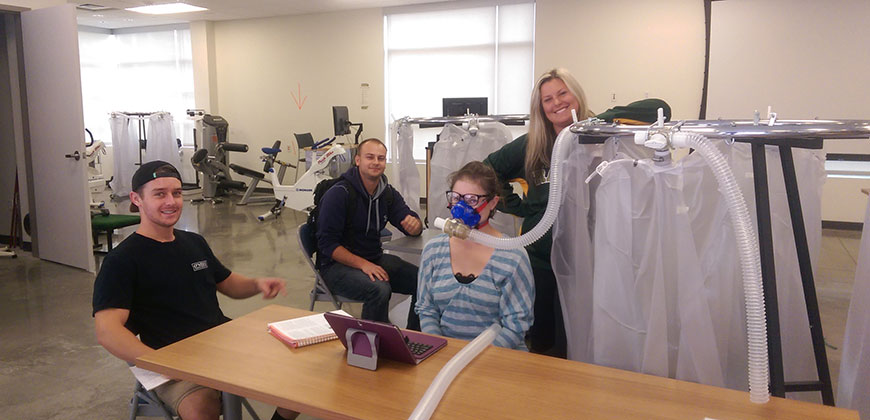
Statistics students have performed an analysis of ideal growing conditions for the endangered monkeyflower. They will present their findings during Celebrate Undergraduate Research and Creativity (CURC), April 17.
Jeff Dodge contributed to this story.
Toiling away at a statistics and computer science double major, fourth-year student Zach Goodenow never imagined he’d someday get to help save an endangered species.
Yet that’s exactly what Goodenow and four classmates will share about during the April 17 Celebrate Undergraduate Research and Creativity (CURC) poster show. Goodenow’s group will join nearly 400 other students publicly showcasing their research, artwork, creative writing and other endeavors during the daylong event at the Lory Student Center.
Growing conditions
Goodenow, with teammates Zhiming Guo, Doran Wood, Jose Amaya Santanach and Sydney Soetaert, have spent the semester using statistical methods to determine ideal growing conditions for an endangered plant species, Mimulus gemmiparus, better known as the budding monkeyflower. Native to the Rocky Mountains of Colorado and under threat of extinction, plant scientists would like to better understand how best to preserve the species in greenhouses.
Goodenow’s group worked on the monkeyflower project for their Statistics 472 Senior Capstone, taught by Associate Professor Philip Turk in statistics. They partnered with Dyan Harden, a CSU graduate student in the Department of Horticulture and Landscape Architecture.
In support of Harden’s graduate research, the students conducted a statistical analysis based on her experiments with 125 second-generation monkeyflowers from four distinct populations. The students’ goal: to determine the ideal moisture content for storage of the flowers’ bulbils – their reproductive elements analogous to seeds – and to subsequently provide data on the “sweet spot” for growing conditions. The project variables included days post-harvest, percent of bulbils able to germinate, and moisture content of each bulbil.
The students’ work should provide an estimated range of days post-harvest that result in the highest viability of bulbils. They’re finishing up their analysis now, in time to present it at CURC.
A lover of math, statistics and data, Goodenow is thrilled with the opportunity to apply those hard-earned skills to the possible preservation of a threatened species. He’s looking forward to sharing about those efforts.
“I’ve spent years learning stats, and doing practice problem after practice problem,” he said. “Now for this capstone, I am learning so much about statistical methods to look at, and different steps to take, in solving a problem that could really make a difference in the world.”
Desk chairs and exercise balls
Nicole Segaline, a senior Health and Exercise Science major, will also be presenting some findings at CURC that are bound to be interesting – especially to anyone who sits at a desk all day.
She analyzed the results of a research project conducted by other HES majors in a capstone course last fall, and discovered that those who sit on an exercise ball or stand at their desks during the workday expend more energy than those who sit in a traditional chair. In fact, Segaline calculated that someone sitting on an exercise ball could actually lose 6.4 more pounds per year than someone who spent that time in a chair. Those who use standing desks stand to lose 3.6 more pounds a year.
“So small changes can add up,” Segaline said. “Over the course of a year, it made a difference.”
About 100 students worked on the research last semester, and 20 of them served as test subjects. They each spent 10 minutes typing on a keyboard in three different circumstances: sitting on an exercise ball, standing and sitting in a conventional desk chair. The students hooked the subjects up to equipment that measures the amounts of oxygen inhaled and carbon dioxide exhaled — revealing the number of calories burned per minute. They also measured subjects’ heart rate and perceived levels of exertion.
Segaline compiled and analyzed the data, assuming that 3,500 calories burned equals one pound, and extrapolating the 10 minutes to a 40-hour work week and, ultimately, an entire year.
“Actually seeing the numbers is cool,” she said. “And those figures are just for one year. If you did it longer, it could really add up and help address our obesity epidemic a little bit.”
According to her abstract, nearly 86 percent of Americans in the workforce have sedentary jobs where they spend at least eight hours sitting. Two out of every three adults in the U.S. are considered obese or overweight, and only 3 percent to 5 percent meet the government’s recommended daily physical activity guidelines.

Health and exercise science majors supplied data for Nicole Segaline’s analysis of how much weight a person could lose sitting on an exercise ball instead of a desk chair. Segaline will present those findings during CURC, April 17.
From calligraphy to elephants
The public is welcome to attend CURC, which will take place April 17, 10:30 a.m.-1:30 p.m. in the Lory Student Center Ballroom. Every college and a diverse array of disciplines will be represented. A small sampling of other projects available for perusal: elephant photography, Islamic calligraphy and art, and research on the effects of radiation in wild boar after the Fukushima nuclear disaster.
Also during the April 17 CURC showcase, pick up your Passport to Discovery.
CURC student presenters will compete for prizes in the following categories: research, service-learning, writing, art and oral presentation. The CURC awards ceremony will be April 25 from 5-7 p.m. in the Lory Student Center Ballroom.